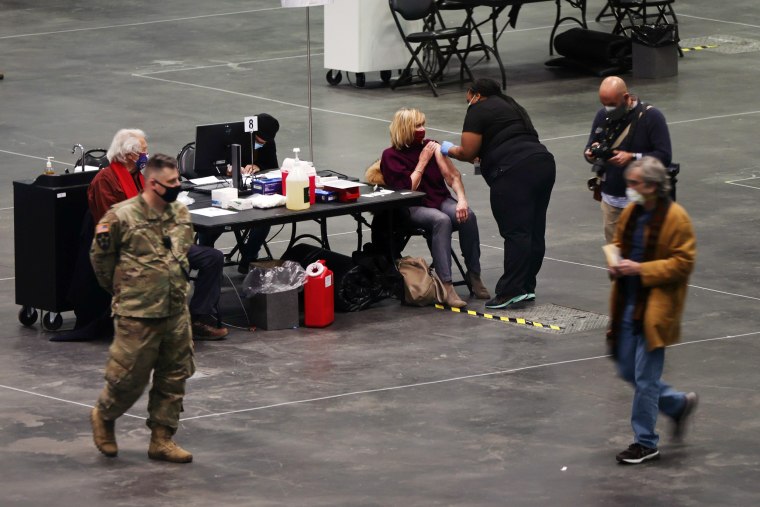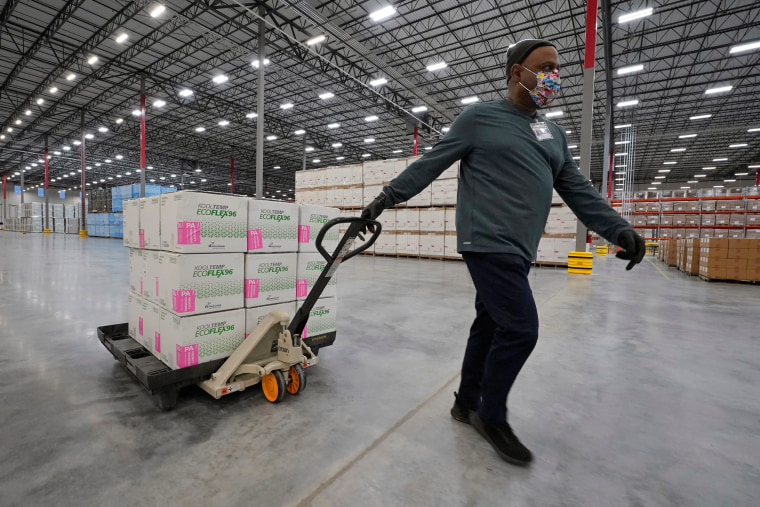One of the world’s leading experts on getting supplies to catastrophe survivors likens the nation’s struggle to get Americans vaccinated against Covid-19 to an understaffed grocery store.
“From a supply chain perspective, you’ve got the production, you’ve got the distribution, it’s on the shelves and there is demand,” Philip J. Palin told NBC News. “But you don’t have enough check-out lanes and you don’t have enough checkers.”
And Palin would know. The former National Academies of Sciences, Engineering and Medicine consultant and author of books like "Out of the Whirlwind: Demand and Supply After Hurricane Maria" is also the son and grandson of grocers.
In a bid to boost the pace of vaccinations, the Trump administration’s Operation Warp Speed announced Tuesday it was revamping its guidelines and recommending that states expand access to Covid-19 shots to everyone 65 and older, not just front-line health care workers and retirement home residents.
“Every vaccine dose that is sitting in a warehouse rather than going into an arm could mean one more life lost," Health and Human Services Secretary Alex Azar said.
Palin applauded the move but said the feds also need to address one of the chief reasons for the ongoing bottlenecks, which is a lack of vaccination venues in areas where the population is the densest.
"Customer-service is especially important if we want millions to return for their second doses," Palin said in an email.
President Donald Trump, whose erratic leadership during the pandemic affected his re-election bid, had vowed that 20 million people would be immunized by the end of 2020.
But as of Wednesday, 27.7 million doses of coronavirus had been distributed, with just 9.3 million people receiving their first shots, according to the federal Centers for Disease Control and Prevention vaccination tracker.
New York Gov. Andrew Cuomo announced that the state was adopting the new federal guidelines and that all New Yorker ages 65 and over can get vaccinated, not just front-line health care workers and nursing home residents.
“I urge patience as unfortunately there are far more eligible NYers than there is vaccine supply from the federal gov.,” Cuomo said in a tweet Tuesday
Meanwhile, New York City Mayor Bill de Blasio said on a local TV news program that the city was picking up the pace of vaccinations and announced the opening of vaccination sites in all five boroughs, including one in Queens at Citi Field, home of baseball's New York Mets.

De Blasio also warned that his city could run out of the Covid-19 vaccine in less than two weeks.
Supply chain experts said that if the vaccine rollout had been done correctly, New York City would already be out of doses — and thousands more people would have been inoculated by now.
“The fact of the matter is, New York State is getting about 300,000 dosages per week and are unable to vaccinate at that rate,” Michael Einhorn, president of the medical supplier Dealmed, told NBC News. “In a proper rollout the state would not be running out of supply in two weeks, but immediately.”
But the sluggish pace of vaccinations is not just a New York City problem. And the government numbers of how many doses have already been distributed don’t tell the whole story, said Julie Swann, who heads the industrial and systems engineering department at North Carolina State University.
“The data from the CDC and Warp Speed shows doses distributed, which means shipped out of the warehouse or production facility,” Swann told NBC News. “It can take two days or so to reach a particular location.”
Also, said Swann, “there is a lag in administration of doses, since providers have up to 72 hours to report that information.”
Palin said that vaccine production has far out-paced the state and local governments' abilities to distribute the doses. While it is important to follow federal and state guidances, experts said that if there’s any vaccine left over after the first waves of people have gotten their shots, it should be used to just inoculate whoever is around to avoid wasting the supply.
In hardscrabble Paterson, New Jersey, there were 110 doses from the city’s first shipment of 1,600 vaccinations left on Monday morning when the city’s health officer, Dr. Paul Persaud, made the decision to give them to whoever else showed up. Within an hour they were gone.
“We are administering the vaccine on demand, and people are coming from many different places,” Persaud told NJ.com. “I don’t want them (doses) sitting on the shelf if there’s a demand for the vaccine."
Einhorn agreed that expanding the pool of people to break through “this crippling bottleneck” is a smart move.
“I understand there may be people cutting in line, I understand there may be people forced to wait, and there may be issues,” Einhorn said. “But the way the rollout has gone thus far, it seems we would be in a better situation if we were giving out vaccines to everyone rather than waiting around to make it perfect.”
Perfect is not the word that would describe what happened in Florida when Gov. Ron DeSantis gave the go-ahead just before New Year’s Eve to start vaccinating senior citizens ahead of essential workers, as the CDC recommended.
As he had done since the start of the pandemic, DeSantis left it up to the counties to decide how to administer the vaccines, and the result was chaos.
The deluge of callers crashed hospital phone banks and county computer systems statewide. And the first-come, first-serve rollout that several counties put into place resulted in hundreds of senior citizens shivering through the night in long lines at testing centers that quickly ran out of vaccine.
Since then, the rollout has gone much smoother, DeSantis insisted. So much so, he said, that now Florida is having to contend with visitors trying to get vaccinated.
"We're not doing any tourists. Some of these nursing home people may live here six months of the year, so that's a little bit different," DeSantis said. "We have people all over the country, because we put seniors first and because people actually see shots going in arms, you have literally people all over the world and all over the country calling here to see. We're not doing that, we're not doing it for tourists, we're not doing it for interlopers."

